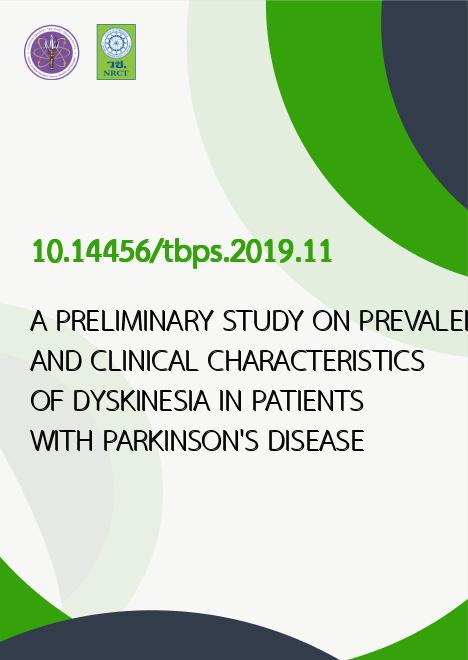
|
A PRELIMINARY STUDY ON PREVALENCE AND CLINICAL CHARACTERISTICS OF DYSKINESIA IN PATIENTS WITH PARKINSON'S DISEASE |
|---|---|
| รหัสดีโอไอ | |
| Creator | Siranan Klanbut |
| Title | A PRELIMINARY STUDY ON PREVALENCE AND CLINICAL CHARACTERISTICS OF DYSKINESIA IN PATIENTS WITH PARKINSON'S DISEASE |
| Contributor | Napapat Piyaparneekul, Chananan Khongbut, Chaisiri Luangsinsiri, Kulthida Methawasin |
| Publisher | Faculty of pharmacy, Silpakorn University |
| Publication Year | 2562 |
| Journal Title | Thai Bulletin of Pharmaceutical Sciences |
| Journal Vol. | 14 |
| Journal No. | 2(July-December)2019 |
| Page no. | 15-30 |
| Keyword | Parkinson's disease, dyskinesia, clinical characteristics |
| URL Website | https://www.tci-thaijo.org/index.php/TBPS |
| ISSN | 2586-8659 |
| Abstract | This is a retrospective study which was conducted between May and June 2017 at HRH Princess Maha Chakri Sirindhorn Medical Center (MSMC). The objectives of this study was to identify prevalence and clinical characteristics of dyskinesia in patients with Parkinson's disease (PD). Data were collected from the medical records of patients who were diagnosed with idiopathic PD between January 1st, 2007 and December 31st, 2016. The eligible criteria were patients who had at least 1 followed up visit within 6 months after an initiation of anti-Parkinson's medications. We analyzed the differences in variables between patients with dyskinesia and without dyskinesia, using Independent t-test or Mann-Whitney U test for continuous data and Chi-Square test for categorical data. After the medical records of 303 idiopathic Parkinson's disease patients at MSMC were reviewed, only 189 patients met all of the eligible criteria. And for the eligible patients, 53.4% were female, the mean age of the group was 73.98 ? 9.82 years, and mean disease duration was 5.50 ? 4.12 years. The prevalence of dyskinesia was 10.1% (19 patients in 189 patients). Compared with no dyskinesia group, the significant factors associated with dyskinesia were male gender (p = 0.044), younger age (p < 0.001), early onset of PD (p < 0.001), receiving entacapone (p < 0.001), high levodopa daily dose (p = 0.005), high total levodopa equivalent daily dose (p<0.001) and taking levodopa more than 500 mg/day (p = 0.008). In conclusion, the findings of this study showed the low prevalence of dyskinesia (10.1%) and factors associated to dyskinesia were male, younger age, young onset of PD, entacapone exposure, high levodopa daily dose especially more than 500 mg/day and high total levodopa equivalent daily dose. Therefore, those patients with the factors associated with of dyskinesia should be closely monitor for the presence of dyskinesia after starting their anti-Parkinsonian drugs. |